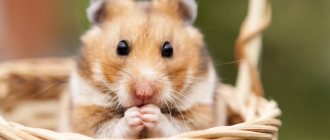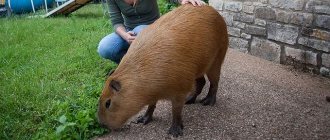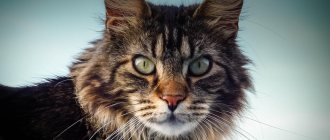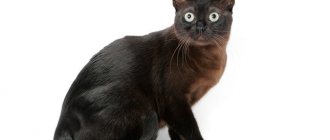The dream of many children is to have their own pet, and often a cat. Cats often serve an important role for children: they provide constant contact, keep secrets, and listen. The purring is soothing, and watching the animal play is a pleasure.
In preschool age, children learn better how to carefully and properly handle pets. At this age, children can help care for the cat under the supervision of their parents. However, of course, we must not forget that each animal has its own character, likes and dislikes. Consider below which cat breeds are still suitable for children.
American Curl Shorthair
"Curl" means "wrinkled" and this leads to the characteristic feature of this cat breed - its ears curled back. This feature arose as a result of a random mutation and was specially bred.
This is a family cat par excellence due to its pronounced good nature. She is gentle and forgiving towards small children. With older children she enjoys more daring games. A little wary of strangers. She enjoys cuddling with her owners, although she usually has a main reference.
The American Curl Shorthair also gets along very well with other pets, whether they are other cats or dogs. The cat is a very sociable cat who definitely doesn't want to be left alone. Despite their balanced, rather calm character, cats of this breed need a lot of exercise.
The noticeably curled ears are a trademark. Depending on the degree of inclination, they are more or less bent back. The coat is short, smooth and silky, with almost no undercoat. All colors are allowed. Females weigh up to 7 kg, males - up to 12.
Be sure to involve your child in the choice, do not give a personal gift - a pet
Also pay attention to the character, temperament of your baby, whether he has diseases (for example, an allergy to wool), the size of the apartment, income (some breeds of cats require certain and obligatory expenses). All worries will still fall on you, think about it - do you need this? Or is it easier to refuse your child? If your answer to the first question is yes, then move on to our rating of kitten breeds for your children!
The oldest cat breed in the world, the Persian is a loyal, gentle, non-obsessive, and affectionate pet with a balanced character, who loves to sit in arms and cuddle. The owners note a certain patronizing and condescending attitude on the part of the pet. Not suitable for noisy hours, for children and adults with allergies; they constantly need to take care of the coat, comb out tangles, while at the same time receiving a portion of communication.
Bombay
Bombay was created in the USA in 1958. In the late 1950s, American breeders wanted a cat that had the texture and appearance of the Burmese, but also had a deep, glossy black color. This breed would resemble the Indian black leopard. To this end, a breeding program began for the Burmese and the black American Shorthair cat with light copper eyes. The resulting cat was named Bombay after the black leopard, which she actually resembles. Bombay was recognized as a "show cat" in the late 1970s. Although Bombays are still not common, they attract the attention of the public at any exhibition in which they are presented.
The Bombay impresses with its elegant appearance and shiny coat. Despite its bright appearance, this breed is not wild or arrogant; on the contrary, it is very pleasant and peaceful.
Bombay is quite intelligent and, due to his high intelligence, especially enjoys more demanding games, which should never become fast paced. Because she needs a lot of rest and a refuge in which she can retire if necessary. However, in most cases, the cat wants to be noticed by its owners, sometimes they demand this quite annoyingly.
Smart Bombay is trained to walk on a leash and is one of those jokingly called "dog cats." The cat does not require special care, but to keep its coat shiny, it should be brushed several times a week.
The most striking thing about Bombay is his black, silky coat. The build is petite but athletic. Females weigh on average 4 kg, and males - 5 kg. Black fur is dominant, but sable kittens are sometimes born, and some associations allow these kittens to be registered as Burmese. The Bombay's eye color ranges from gold to copper.
General tips and tricks
Having decided which cat is best to get for a child, you need to carefully consider the issue of choosing a specific kitten.
How to choose:
- Age. If it is difficult to determine the age of a street kitten, then you need to buy an animal from a nursery that is 8-14 weeks old. At this age, the kitten begins to be accustomed to adult food, it is sufficiently socialized, it is easy to accustom it to the toilet and the rules in the apartment.
- Health. You need to look under the tail: the anus should be dry and clean. Health criteria: eyes and ears without discharge, clean shiny fur, belly is round, but not tight or sunken.
- Behavior. A healthy kitten should be playful, curious, and active. A cat that is too cocky or too quiet means problems with upbringing in the future.
You need to pick up the kitten you like and look at its reaction. Lack of aggression, calmness and a share of healthy curiosity is right.
If the kitten is interested in its future owners, it is possible that it was for them that it was born.
Turkish Angora
The noble Angora celebrated success as one of the oldest cat breeds of the Ottoman Empire. It was recognized as a breed back in the 15th century. Angora" is the old name of Ankara. For a long time, the Angora cat was understood as all cats with long hair, mostly white. The term is still used today outside of specialist circles and is sometimes used colloquially as a synonym for Turkish Angora.
This breed arose without human intervention. She is distinguished by her special loyalty, which is often compared to dogs. Because she follows her guardian every step of the way. Most of the time she hopes to be petted, as she needs a lot of love and pleasant sensations. The Turkish Angora is usually an easy-going personality that gets along well with everyone: with its relatives and other pets such as dogs, and, of course, with its owners.
This breed is an excellent playmate for children. Because their joy from playing practically knows no bounds and hardly diminishes with age. The cat also likes to fetch smaller toys, which regularly excites children. She attracts attention by purring and stroking her legs. If a cat feels neglected, it may become withdrawn. In addition to careful care, she also needs a lot of space to be able to live to her satisfaction. The cat has semi-long, silky fur that fits tightly to the body because it has no undercoat. The colors are white, black and red with different shades. The body is long and slender, at the same time muscular, although the cat looks fragile. Even male cats hardly exceed 4 kg.
Siamese
Siamese are called dogs in cats' skin. This breed has an interesting feature - its voice: Siamese are able to change the pitch and tone of sound due to the structure of the vocal cords. They need physical contact, so they are sociable and playful.
This is a good friend for children, because the Siamese cat can be trained, it loves active movements and bustle. If a Siamese takes a child under his wing, he will protect and love him until the end of his days.
The Siamese have no equal in their ability to achieve their goals, even the most mischievous ones. They love to jump and move around on top, so a play area with high platforms should be made for them in the apartment.
It is believed that Siamese cats are vindictive and take revenge for insults, but this is a myth, because excellent long-term memory is characteristic of all cats: they are able to remember throughout their lives what impressed them.
A short-haired Siamese only needs to be brushed occasionally; it can be taught to swim from childhood - these cats love to swim in warm water.
Long-haired varieties of Siamese are the Balinese and Burmese cats.
Abyssinian
The Abyssinian's roots are in Southeast Asia, and they are one of the most bred cat breeds in the world. It came to Europe in the 19th century and was registered in Germany in 1933. Like many other cat breeds, the Abyssinian's survival was threatened during and after the two world wars.
No matter how many animals live in a farm that provides entertainment, the Abyssinian is very human-oriented. The Abyssinian cat looks at people with curiosity, and especially at children. A smart kitten carefully records every action. Cats love children very much, and boredom and excessive rest are out of the question.
The Abyssinian is slender and finely built, with long legs. Reaches a shoulder height of 40 and a length of 60 cm. Cats weigh from 2.5 to 4 kg, males - from 3.5 to 5 kg. The coat is short and has no pattern in purebred Abyssinians.
The short coat of the Abyssinian does not require special care. It should be brushed from time to time; cats shed in the spring. She needs a lot of attention, movement and variety.
To overpay or not to overpay?
When purchasing a cat, you may come across different prices, and in different regions they differ significantly, so the question arises, why in some places they give purebred cats for absolutely nothing, and in other places they ask for fabulous money for them? This all depends on several factors:
Each nursery must maintain its own brand. It’s the same as with selling things: branded clothes are much more expensive than similar Chinese products
The nursery will provide you with documents for the kitten, which will indicate its pedigree, and this is very important if you want to reproduce the animal in the future. Of particular value are show-class kittens whose parents took prizes in shows and exhibitions.
If this is not important to you, then you shouldn’t overpay. Compliance with breed standards. Experts will immediately suspect incest in the kitten’s appearance. This is called a defect, a deviation from the breed. Sometimes such defects can occur in a kitten of purebred parents. But still, it is not suitable for exhibitions, unlike its successful brothers and sisters, and therefore its price will be much lower. The age of the kitten also plays a role. It is best to sell it at the age of 2-3 months. Older kittens are considered “grown up” and are cheaper. Sometimes it happens that a kitten is sick, and the owners try to sell it quickly while the disease is not noticeable. In this case, the price may also be low.
Javanese cat tolerates loneliness without owners during the day
There are different cases, for example, at the poultry market, a purebred kitten can be bought for ridiculous prices. Owners sometimes don’t know how to quickly get rid of their offspring. If you are not interested in exhibitions, medals and regalia, then this is also a good option for purchasing a furry miracle. It’s up to you to choose which cat is best to have in your apartment.
Important! If you want a cat to perfectly suit your lifestyle, then it is better to take an animal from breeders. They will tell you which cat is best to have in your apartment and select a pet for you, taking into account your interests
But it’s worth telling about your wishes in more detail so that there are no disappointments later.
They will tell you which cat is best to have in your apartment and select a pet for you, taking into account your interests. But it’s worth talking about your wishes in more detail so that there are no disappointments later.
For example, it is very important to know how long you will be away, since some breeds cannot tolerate loneliness, it is also important whether you have enough time to care for the cat, this is important for long-haired breeds, whether you plan to have offspring, etc.
Ragdoll has an easy character
A good breeder is also interested in ensuring that his kitten ends up in kind and caring hands. It may take time for you to choose the right option, but if your desires and capabilities coincide, you will gain a reliable friend for life.
Norwegian forest
The breed has been specially bred only since 1930, Norwegian Forest cats have no hereditary diseases and usually have good health.
However, the athlete cat is extremely active, a gifted climber, and constantly fulfills her desire to move. Throughout her life, she has enjoyed playing outdoors, even in inclement weather.
The beautiful Norwegian is not a cat that needs to be looked after from morning to night. On the contrary, it is economical in care.
The Norwegian Forest Cat is very affectionate with children and enthusiastically spends time with them. Due to its gentle nature, this cat is also suitable for families with small children, to whom it treats with great attention. Because she is straightforward, open-minded and quite tolerant.
The Norwegian Forest Cat is an imposing figure. This is due, on the one hand, to their size (shoulder height 45 cm, females weigh from 3.5 to 7 kg, males from 5 to 9.5), on the other hand, to their half-length body, which is especially thick in the area neck. It consists of a dense undercoat and a long, dense topcoat. The body is strong and athletic.
The Norwegian Forest Cat is easy to care for. She does not need constant outside employment and, as a rule, she is quite thrifty. Because the top coat repels moisture and dirt, your cat only needs to be brushed once a day. In principle, even once a week is enough.
Who is the Ragdoll suitable for?
Representatives are ideal only for owners who are ready to fully emotionally devote themselves to communicating with their pet. Ragdolls are extremely obedient, but they become very stressed if they do not receive enough attention or reciprocity.
The breed is worth considering if you are planning to have children. Many cats cannot withstand the “pressure” of children's attention; Ragdolls in this sense are extremely patient and gentle. But there is also the other side of the coin, the pet will not defend itself, even if the child unknowingly causes harm, so the child should not be left alone with the pet.
Naturally, the Ragdoll is suitable only for those owners who realize that despite its “doll” character, the pet is not a toy. Many people have the mistaken impression that feeding and a tray are enough to keep a cat, and when the pet gets tired, it can be “put on a shelf.” Ragdolls have a delicate mental structure, and they suffer in silence, so think carefully about your options before getting a kitten.
British Shorthair
The British Shorthair originated quite accidentally in 19th century Britain from domestic cats that once arrived on the island with the Romans, and various breeds. The thick fur looks like plush.
The British Shorthair cat is very fixated on people and absolutely demands attention - anywhere and at any time. The shy cat usually gets along well with other animals, especially if they have been socialized from an early age. Despite all its coziness, the powerfully built British Shorthair is also a good hunter who persistently pursues its prey.
The cat is stocky - this is due to thick hair, on the one hand, and a strong physique, on the other. Females weigh from 4 to 6 kg, males - from 7 to 8. Fur colors are very varied, but the ash color is especially popular among breeders and owners.
What breeds should you avoid?
Felinologists do not recommend having breeds similar to predatory cats : Chausie, Caraquet, Savannah. They have a developed wild side, so cats use their fangs and claws to protect themselves.
For example, representatives of the interracial Savannah breed are labeled F1-F7. The lower the number, the more wild blood the animal has. Such animals are suitable exclusively for aviary keeping.
The Chausie breed is also classified into 4 stages F1-F4. Cats marked F4 differ little in size from domestic cats and have the maximum level of socialization, but still are not suitable for families with children.
Siberian
It acquired its current appearance in Russia. It also came to Western Europe in the 80s of the 20th century. In 1998, the International Cat Federation recognized Siberian cats as a separate breed.
Children love them and can play and tinker with them for hours. At the same time, the cat never becomes aggressive and is especially attentive to small children.
Thus, the Siberian cat is a true family cat that gets along well with everyone. However, she usually has a loved one who loves her especially. Despite all the affection, the Siberian cat, like all representatives of natural breeds, is an excellent hunter with a great impulse to move.
The Siberian cat has semi-long, silky hair that comes in different colors and a fluffy tail. The body is quite large and muscular. Females weigh on average 4.5 kg, males 6 kg. The eyes are slightly slanted and come in a variety of colors, especially bright blue. Caring for a Siberian cat is similar to caring for a domestic cat. The Siberian cat needs a lot of exercise and affection.
Outbred
It is unknown what character traits a cat adopted from the street or from a shelter has. She may turn out to be a playful fidget, a calm aristocrat, or a feisty one.
However, most often, street kittens quickly become attached to a person and accept the rules of behavior in the apartment.
Such cats are not very sociable - this is fixed at the genetic level. But the former homeless animal is self-sufficient, not annoying and unobtrusive. At the same time, an even, warm relationship is built with children, but the kitten is unlikely to allow itself to be commanded.
After adopting an animal from the street, owners need to do a full veterinary examination.
Peterbald (Petersburg Sphynx)
Although hairless cats were bred primarily through Sphynx cats, they remain a very popular sight. However, they can be a boon for allergy sufferers. The Peterbald, like other representatives of this category, is a wonderful, sweet cat.
Peterbald owes its name to the Russian city of St. Petersburg. There he was first bred in 1994 from a pair of Don Sphynx and Oriental Shorthair.
Like its close relatives, the Peterbald is very attached to people. He prefers to cuddle and play with his loved one. He is also very open towards all residents in the house, including other pets, which he treats with great tolerance.
Peterbald especially appreciates children because they are as playful as he is. The Peterbald has no fur, only a little fluff. This is their most noticeable feature. The cat itself is slender and muscular, and can weigh up to 4 kg. The Peterbald does not require any grooming, but the skin must be protected from cold and sunlight.
How to choose the right one
Naturally, character and appearance are not all that you need to consider before buying a pet. Even the best cat breeds for children are naughty in childhood, have individual characters and needs, are you ready for this? Many people believe that keeping a cat is easy because you don’t need to walk it. Yes, the absence of constant walking makes the owner’s life easier, but does not make the burden of responsibility any easier. A cat deprived of communication can turn into a tyrant who will be ready to commit any sins just to attract attention.
All responsibility for a new pet falls on the shoulders of the parents, so before choosing a cat breed for a child, think carefully! If the child changes his mind or decides that the cat is no longer interesting, this means that you will need to not only feed the pet and clean up after it, but also devote time to it. In addition, a visit to the veterinarian, treatment, if the pet is overtaken by an illness, will fall on your shoulders.
Your child is not able to fully take care of a four-legged animal, if only because he does not work, has no income and is not ready to be responsible for preserving life or health. And you, as an adult and a parent, need to be prepared. So, if you don’t know whether you (not the child, but you) want a cat, then you don’t need to get one! It is better to disappoint a child than to break the whole world of a defenseless four-legged creature.
The following can be said in favor of cats:
- Children who grow up near animals get sick less often and are less prone to allergies.
- Cats have long been recognized as natural antidepressants, and for a child going through the exciting stages of growing up, an extra friend (even a four-legged one) will not hurt.
- Cats and dogs sleeping next to children “protect” them from bad dreams.
- Children who take care of animals become excellent parents (here, responsibility and care should not be confused with living together).
- There is no doubt that caring for a pet ensures that your child learns to think beyond himself and be responsible.
A cat sometimes becomes an ideal pet for an apartment. For a growing child, you need to choose a sociable and active four-legged dog. If you need a breed for a family with children, it is better to choose discreet, tolerant, calm cats. What about the fact that many people take care of the order in the house and only for this reason do not get a pet? Think about it, we are talking about a cat that may be short-haired or even hairless. With timely prevention of worms and fleas, your pet will be absolutely safe. If you accustom a cat to a scratching post and litter box, neither the furniture nor the apartment will be damaged. Returning to the question above, what are potential owners worried about, the clutter or the responsibility they will have to shoulder?
Are you still confident in your decision? Then let's look at cat breeds that love children , yes, exactly those cats that love children. Agree, each animal is individual and may not have affection for children... which is even a little reasonable. Children often hurt animals, even if these are not intentional actions, but the pet experiences discomfort. Only a sincerely loving four-legged dog will not fight back until it is driven into a corner.
Advice: do not give a cat to a child, it is better to choose a kitten together.
The choice of breed should be made based on the character of your child. The temperament of any, even the most affectionate cat, can be turned into evil if the pet is abused or does not receive proper care. When choosing a kitten (not breed), you need to pay attention to:
- Contact – like people, cats are distinguished by their temperament and sociability.
- Reactions to loud sounds - the kitten should be interested, not afraid. If your baby is afraid of noise, you shouldn’t take him, since living in the same house with a child will be completely stressful for him.
- Curiosity - the baby should show looseness in relation to an unusual object. Usually the kitten is scared, but curiosity takes over.
- Meows or meows - talkative kittens usually do not change their habits.
Breeds that are suitable for living with children usually have the following requirements:
- The absence of a defensive-aggressive reaction - that is, the cat would rather run from fear than rush at the enemy.
- Low level of territoriality.
- Moderate to high activity level.
- Sociability and affectionate disposition.
- Love of care - that is, the cat should be calm about combing, caring for claws, etc. This trait depends more on upbringing.
- High stress resistance, ability to quickly adapt.
- As low maintenance as possible.
Note! Cats should not be beaten even for educational purposes, and if the pet is constantly near the child, this can end in tears. A stressed animal may become irritable and attack the child.
Calm cats
British
pros
- friendly
- tolerates loneliness well
- clean
- easy to care for
Minuses
- picky about food
- wayward
Britons are smart, friendly, and get along quickly with kids. Their undeniable advantages are calmness and equanimity. They do not show aggression in games, even if children are overly active. They don’t really like to run, they lie down more, especially cats. Children really like their appearance: large, with soft fur, similar to their favorite plush toy. They do not tolerate being picked up. They happily sleep in cribs with their children.
Scottish lop-eared
pros
- calm disposition
- cute appearance
- good health
Minuses
- independence
- picky eating
The Scots love to communicate with children, they are calm, intelligent and quite flexible in games. Adults should explain that a pet of this breed does not tolerate anyone encroaching on its freedom - they often pick it up, drag it and cuddle it. You need to play with him on equal terms, show respect and patience. Then he will respond with true friendship, will be affectionate and gentle. The breed is more suitable for teenagers.
Burmese
pros
- graceful
- don't shed
- non-aggressive
- cheerful
Minuses
- don't like loneliness
- excessive curiosity
The Burmese are sociable, they are friendly and very affectionate. They feel the mood of the owner - they know exactly when to cuddle and when it is better not to approach. They love to play with children, are patient, and do not show aggression, even if something unpleasant is done to them. A Burmese has a particularly good relationship with a child if they met at a very young age - the friendship will last for a very long time.











